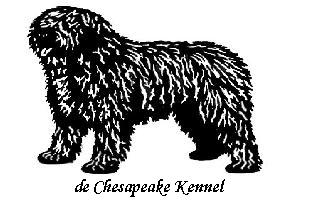
Spanish Water Dog / Perro de Agua Espanol
History
by Craig Pope
Much written about water dogs has assumed that each breed has a separate and unique history. Fanciers of the Barbet(French Water Dog), Laggato(Italian Water Dog), Portuguese Water Dog and the Spanish Water Dog each claim "special creation" of their chosen breed. Yet the concept of a "breed" as a "pure" race of dogs, each bearing characteristics unique to themselves, is a British invention less than 200 years old. The reality of the wooly-coated herding dog as a genre is nearly six thousand years old.
It is generally accepted that dogs were domesticated during the hunter-gatherer period in human history, about 12,000 years ago and were well established by the time agricultural villages began to form 6000 years ago. According to I.L. Mason's book, "Sheep Breeds of the Mediterranean", sheep were first domesticated in the hills of what are now Turkey, Iraq and Syria. It is probable that the livestock-herding dog began its evolution there as well. (Note: Another name for Spanish Water Dog is "Turko de Andalusia" which in Spanish means Turkish dog of Southern Spain.)
There are many theories as to how the wooly-coat dog arrived in Iberia(Portugal, Spain, Southern France and Western Italy). One is that the Moors brought them, another theory suggests that the Romans brought them into Iberia. And yet another theory suggests an Asian origin. There is probably not one single correct answer, they may all have contributed. I tend to believe that as trade from Europe, through the Middle East to India and China increased, animals, grain and ideas were transported as readily as gold, spices, frankincense and silk. The "Silk Route" opened Europe to ideas and agriculture from the East. The Silk Route was not a single road but a number of interconnecting caravan and ship routes over which trade was conducted for thousands of years.
As livestock moved back and forth along these routes, it is unlikely that bitches who whelped en-route could be spared time to raise their litters. Newborn pups left with local villagers along the way supplied new genes for the resident wooly-coat population and except for regional preferences in color and coat texture, the dogs from Portugal to Turkey soon resembled each other more than they did either their wild ancestors or the common village mongrels.
By 1100 AD a wooly-coated dog existed throughout Iberia. Although the wooly-coat dog continued to possess his forefatherís genes for hunting and herding livestock he soon started to use his other talents to the task at hand. A type of natural selection, with human intervention was beginning to take place, he was being bred for specific tasks. For example; in the Seafaring regions of Portugal and Spain he was revered as a great assistant to the fishermen. Retrieving objects that had fallen overboard and towing lines to and from ships. In France he was prized for his great nose and courage to traverse any terrain to track and retrieve game. In Italy he put his keen nose to work at finding truffles. However in Southern Spain, the wooly-coated dog continued to be prized for his versatile talents, herding, hunting and retrieving.
In the early 1800's, the British as well as the French, having begun the development of "pure" breeds of livestock through inbreeding, applied the same principle to their dogs. By the 1850's, they were writing Standards and holding exhibitions. When a new "breed" was proposed, the fanciers of that breed wrote the Standard to fit the dogs they themselves owned. As the custom spread throughout the European Continent, influential fanciers collected groups of dogs, described them in a Standard, and proclaimed the "discovery" of an "ancient breed". National pride often dictated the subtle differences that identified a dog as belonging to one country and not another. In reality, the common man, the nomadic shepherd, the fishermen or the hunter did not care what country a dog came from as long as the dog did the work at hand.
Throughout the ages, the Spanish herders must receive the bulk of credit for maintaining a healthy breeding stock of wooly-coated dogs, which is known today as the Spanish Water Dog. Unlike the Portuguese Water Dog, the French Barbet and the Italian Laggato whose genetic diversity is almost non-existent. The Spanish Water Dog continues to do the job for which he was originally bred; he is still herding sheep and goats in the rugged countryside of Spain and is actively used as a retriever of waterfowl and upland game bird dog. More recently he is being utilized as Search and Rescue dogs as well as Police dogs sniffing out explosives or drugs.
In conclusion, the wooly-coated dog of Iberia has both changed and remained the same for millenniums. Social, economic, and political changes have had devastating effects on wooly-coat; as the fishing industry has changed to become more mechanized, as hunting has changed from subsistence to sport and as sheep and goat raising countries continue to decline, the opportunity for our dogs to perform and be bred for their traditional tasks is decreasing. We hold the future of the breed in our hands! For the good of the breed and the dog community as a whole, we must do our best at maintaining a healthy breeding stock of Spanish Water Dogs dogs that possess both their unique appearance and flamboyant character.






